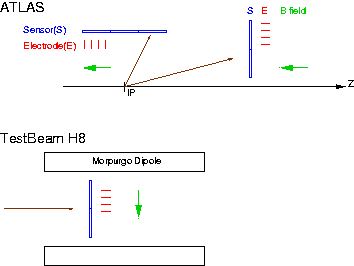Introduction
This is a proposal for a Run Plan for the May 2009 3D TestBeam at CERN/H8. The main focus of the testbeam will be the measurement of the 3D sensor characterics within a magnetic field. Sensors will be positioned inside the Morpurgo Super Conducting Dipole magnet (1.9T).
However, if the main focus should be measurements within magnetic field, two new sensors from FBK and CNM will be tested for the first time in beam. These new sensors should be compared to the Stanford reference sensor with magnetic field on as well as magnetic field off.
Sensors
we are planning to test 4 sensors in parallel:
- Stanford 3E reference sensor (tested in beam in 2008)
- Planar reference sensor
- New 3D FBK sensor
- New 3D CNM sensor
Test Beam and ATLAS sensor positioning
Below is a cartoon of the positioning of the 3D sensors, both in ATLAS (barrel and endcap region) and in H8:
In ATLAS, the magnetic field is parallel to the 3D Electrodes in the EndCap region and perpendicilar in the barrel region. The testbeam will therefore test the ATLAS barrel configuration.
Expected effects due to the magnetic field
In the barrel region, given the direction of the E and B fields, charges will be drifted to the surface of the sensor, and will be trapped, recombined, etc... in the p-spray layer (or the oxide layer?). What happens there is not fully understood (by me!). Some charges will be collected by the read-out electrodes (some in-time but some delayed), and some won't. The effect is therefore a loss of efficiency. In the barrel region, contrary to planar sensors, there is no charge sharing effect.
Question: do we need to understand what happens when charges are drifted to the surface of the sensor, and what measurement could we do to quantity the effect?
As Chris pointed it out, the effect will of course depend on the magnitude of the field but also on the sensor itself. That's why it important to test the sensors for various magnetic field (at least 1.9T and 0T, but also possibly with one or two more points in between).
Proposed Run Plan
Measurements to be performed at each setting:
